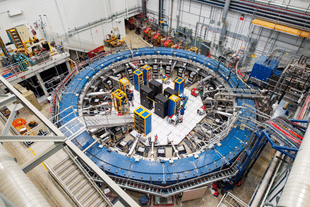Science
In Search Of New Particle Physics: Researchers Achieve Most Precise Measurement Of A Crucial Muon Property
Karan Kamble
Aug 15, 2023, 06:13 PM | Updated 06:13 PM IST
Save & read from anywhere!
Bookmark stories for easy access on any device or the Swarajya app.


Researchers have achieved the most precise measurement to date of the "magnetic moment" of the muon, marking a significant advancement in the exploration of new interactions that govern our universe.
An international team of researchers has long been at work on the Muon g-2 experiment at the US Department of Energy's Fermi National Accelerator Laboratory, called Fermilab.
They have now released their highly anticipated updated measurement of the muon's magnetic moment, which has been published in the journal Physical Review Letters.
This latest measurement builds upon the initial results of the experiment announced in April 2021, demonstrating an improvement in precision by more than a factor of two.
"It improves the precision of their previous result by a factor of 2 and sets up a showdown between theory and experiment over 20 years in the making," Fermilab said.
The measurement boasts an uncertainty of 0.2 parts per million, making it the most accurate ever achieved using a particle accelerator.
Muons, which are fundamental particles similar to electrons but significantly heavier, possess "internal magnets" that cause them to "wobble" in the presence of a magnetic field, much like the axis of a spinning top.
The rate of this wobbling, known as the magnetic moment of the muon and typically represented by the letter g, depends on various factors.
According to theory, g should equal 2 at its simplest level. However, any deviation from 2, referred to as g minus 2 (g-2), can be attributed to the muon's interactions with particles in the quantum foam surrounding it.
By studying g-2, scientists can gain insights into new subatomic phenomena and potentially discover previously unknown particles.
“We’re really probing new territory," said Brendan Casey, a senior scientist at Fermilab who has worked on the Muon g-2 experiment since 2008.
The speed of the muon's wobble, as measured in the experiment, significantly differed from the predictions based on the Standard Model of particle physics.
The Standard Model explains the interactions between the fundamental building blocks of matter and is governed by four fundamental forces in the universe — gravity, electromagnetism, and the strong and weak nuclear forces.
Media reports, citing scientists, say this development keeps the possibility of finding a new, fifth force of nature alive.
The deviation from the predicted wobble speed suggests that there may be factors not accounted for in the current understanding of particle physics.
An attempt is in progress to reconcile the discrepancy between theoretical predictions and experimental results.
The researchers anticipate sharing their final findings, which will incorporate all of their collected data, in approximately two years.
The Muon g-2 is an international collaboration comprising 181 collaborators from 33 institutions across seven countries.
Karan Kamble writes on science and technology. He occasionally wears the hat of a video anchor for Swarajya's online video programmes.





